Recent Advance in the Fabrication of 2D and 3D Metal Carbides-Based Nanomaterials for Energy and Environmental Applications
Abstract
:1. Introduction
2. Fabrication Methods of 2D MC MXene.
2.1. CVD
2.2. HFA Etching
2.3. Molten Salt Method
2.4. Electrochemical Etching
2.5. Hydrothermal Method
2.6. Summary
3. 2D and 3D Structures of MXene-Based Nanomaterials
3.1. 2D Structures
3.1.1. Hybridized with Polymers
3.1.2. Hybridized with Nanoparticles
3.1.3. Hybridized with Carbon Nanotubes
3.1.4. Hybridized with Graphene
3.2. 3D Structures
3.2.1. Self-Assembled Structure
3.2.2. Hydrogels
3.2.3. Aerogels
4. Applications of the MC MXene-Based Nanomaterials
4.1. Chemical Batteries
4.2. Supercapacitors
4.3. Water Splitting
4.4. Photocatalysts for Degradation of Pollutants
4.5. Heavy Metal Adsorption
4.6. Electromagnetic Shielding or Radiations
5. Conclusions and Outlooks
Author Contributions
Funding
Data Availability Statement
Acknowledgments
Conflicts of Interest
References
- Geng, D.C.; Yang, H.Y. Recent advances in growth of novel 2D materials: Beyond graphene and transition metal dichalcogenides. Adv. Mater. 2018, 30, 1800865. [Google Scholar] [CrossRef] [PubMed]
- Li, G.; Zhang, Y.Y.; Guo, H.; Huang, L.; Lu, H.L.; Lin, X.; Wang, Y.L.; Du, S.X.; Gao, H.J. Epitaxial growth and physical properties of 2D materials beyond graphene: From monatomic materials to binary compounds. Chem. Soc. Rev. 2018, 47, 6073–6100. [Google Scholar] [CrossRef] [PubMed]
- Zhang, H.; Cheng, H.M.; Ye, P.D. 2D nanomaterials: Beyond graphene and transition metal dichalcogenides. Chem. Soc. Rev. 2018, 47, 6009–6012. [Google Scholar] [CrossRef] [PubMed]
- Liu, T.J.; Ding, J.W.; Su, Z.Q.; Wei, G. Porous two-dimensional materials for energy applications: Innovations and challenges. Mater. Today Energy 2017, 6, 79–95. [Google Scholar] [CrossRef]
- Zhang, X.Y.; Hou, L.L.; Ciesielski, A.; Samori, P. 2D materials beyond graphene for high-performance energy storage applications. Adv. Energy Mater. 2016, 6, 1600671. [Google Scholar] [CrossRef] [Green Version]
- Jeong, G.H.; Sasikala, S.P.; Yun, T.; Lee, G.Y.; Lee, W.J.; Kim, S.O. Nanoscale assembly of 2D materials for energy and environmental applications. Adv. Mater. 2020, 32, 1907006. [Google Scholar] [CrossRef]
- Schulman, D.S.; Arnold, A.J.; Das, S. Contact engineering for 2D materials and devices. Chem. Soc. Rev. 2018, 47, 3037–3058. [Google Scholar] [CrossRef]
- Wang, Z.Q.; Wu, S.S.; Ciacchi, L.C.; Wei, G. Graphene-based nanoplatforms for surface-enhanced raman scattering sensing. Analyst 2018, 143, 5074–5089. [Google Scholar] [CrossRef]
- Wang, L.; Wu, A.G.; Wei, G. Graphene-based aptasensors: From molecule-interface interactions to sensor design and biomedical diagnostics. Analyst 2018, 143, 1526–1543. [Google Scholar] [CrossRef]
- Zhang, J.Y.; Chen, H.L.; Zhao, M.; Liu, G.T.; Wu, J. 2D nanomaterials for tissue engineering application. Nano Res. 2020, 13, 2019–2034. [Google Scholar] [CrossRef]
- Chen, H.; Liu, T.J.; Su, Z.Q.; Shang, L.; Wei, G. 2D transition metal dichalcogenide nanosheets for photo/thermo-based tumor imaging and therapy. Nanoscale Horiz. 2018, 3, 74–89. [Google Scholar] [CrossRef] [PubMed]
- Chaudhari, N.K.; Jin, H.; Kim, B.; Baek, D.S.; Joo, S.H.; Lee, K. MXene: An emerging two-dimensional material for future energy conversion and storage applications. J. Mater. Chem. A 2017, 5, 24564–24579. [Google Scholar] [CrossRef]
- Gogotsi, Y.; Anasori, B. The rise of MXenes. ACS Nano 2019, 13, 8491–8494. [Google Scholar] [CrossRef] [PubMed] [Green Version]
- Naguib, M. MXenes: A rising star in the constellation of two-dimensional materials. Curr. Opin. Solid State Mater. Sci. 2020, 24, 100809. [Google Scholar] [CrossRef]
- Han, M.K.; Yin, X.W.; Wu, H.; Hou, Z.X.; Song, C.Q.; Li, X.L.; Zhang, L.T.; Cheng, L.F. Ti3C2 MXenes with modified surface for high-performance electromagnetic absorption and shielding in the X-Band. ACS Appl. Mater. Interfaces 2016, 8, 21011–21019. [Google Scholar] [CrossRef]
- Li, J.; Yuan, X.T.; Lin, C.; Yang, Y.Q.; Xu, L.; Du, X.; Xie, J.L.; Lin, J.H.; Sun, J.L. Achieving high pseudocapacitance of 2D titanium carbide (MXene) by cation intercalation and surface modification. Adv. Energy Mater. 2017, 7, 1602725. [Google Scholar] [CrossRef]
- Liu, G.Y.; Zou, J.H.; Tang, Q.Y.; Yang, X.Y.; Zhang, Y.W.; Zhang, Q.; Huang, W.; Chen, P.; Shao, J.J.; Dong, X.C. Surface modified Ti3C2 MXene nanosheets for tumor targeting photothermal/photodynamic/chemo synergistic therapy. ACS Appl. Mater. Interfaces 2017, 9, 40077–40086. [Google Scholar] [CrossRef]
- Wang, D.S.; Li, F.; Lian, R.Q.; Xu, J.; Kan, D.X.; Liu, Y.H.; Chen, G.; Gogotsi, Y.; Wei, Y.J. A general atomic surface modification strategy for improving anchoring and electrocatalysis behavior of Ti3C2Tx MXene in lithium-sulfur batteries. ACS Nano 2019, 13, 11078–11086. [Google Scholar] [CrossRef]
- Khazaei, M.; Arai, M.; Sasaki, T.; Chung, C.Y.; Venkataramanan, N.S.; Estili, M.; Sakka, Y.; Kawazoe, Y. Novel electronic and magnetic properties of two-dimensional transition metal carbides and nitrides. Adv. Funct. Mater. 2013, 23, 2185–2192. [Google Scholar] [CrossRef]
- Wang, S.G.; Zeng, P.; Zhu, X.H.; Lei, C.Y.; Huang, Y.; Nie, Z. Chimeric peptides self-assembling on titanium carbide MXenes as biosensing interfaces for activity assay of post-translational modification enzymes. Anal. Chem. 2020, 92, 8819–8826. [Google Scholar] [CrossRef]
- Jiang, Y.J.; Zhang, X.N.; Pei, L.J.; Yue, S.; Ma, L.; Zhou, L.Y.; Huang, Z.H.; He, Y.; Gao, J. Silver nanoparticles modified two-dimensional transition metal carbides as nanocarriers to fabricate acetycholinesterase-based electrochemical biosensor. Chem. Eng. J. 2018, 339, 547–556. [Google Scholar] [CrossRef]
- Pan, Y.X.; Zhou, T.H.; Han, J.Y.; Hong, J.D.; Wang, Y.B.; Zhang, W.; Xu, R. Cds quantum dots and tungsten carbide supported on anatase-rutile composite TiO2 for highly efficient visible-light-driven photocatalytic H2 evolution from water. Catal. Sci. Technol. 2016, 6, 2206–2213. [Google Scholar] [CrossRef]
- Chen, M.H.; Zhang, J.W.; Chen, Q.G.; Qi, M.L.; Xia, X.H. Construction of reduced graphene oxide supported molybdenum carbides composite electrode as high-performance anode materials for lithium ion batteries. Mater. Res. Bull. 2016, 73, 459–464. [Google Scholar] [CrossRef]
- Bao, W.Z.; Su, D.W.; Zhang, W.X.; Guo, X.; Wang, G.X. 3D metal carbide@mesoporous carbon hybrid architecture as a new polysulfide reservoir for lithium-sulfur batteries. Adv. Funct. Mater. 2016, 26, 8746–8756. [Google Scholar] [CrossRef]
- Yang, Y.Y.; Qin, Y.; Xue, X.W.; Wang, X.D.; Yao, M.; Huang, H. Intrinsic properties affecting the catalytic activity of 3D transition-metal carbides in Li-O2 battery. J. Phys. Chem. C 2018, 122, 17812–17819. [Google Scholar] [CrossRef]
- Guo, L.X.; Ji, L.L.; Wang, J.Y.; Zuo, S.S.; Chen, Z.F. Walnut-like transition metal carbides with three-dimensional networks by a versatile electropolymerization-assisted method for efficient hydrogen evolution. ACS Appl. Mater. Interfaces 2018, 10, 36824–36833. [Google Scholar] [CrossRef] [PubMed]
- Lei, J.C.; Zhang, X.; Zhou, Z. Recent advances in MXene: Preparation, properties, and applications. Front. Phys. Beijing 2015, 10, 107303. [Google Scholar] [CrossRef]
- Dinh, K.N.; Liang, Q.H.; Du, C.F.; Zhao, J.; Tok, A.L.Y.; Mao, H.; Yan, Q.Y. Nanostructured metallic transition metal carbides, nitrides, phosphides, and borides for energy storage and conversion. Nano Today 2019, 25, 99–121. [Google Scholar] [CrossRef]
- Pang, J.F.; Sun, J.M.; Zheng, M.Y.; Li, H.Q.; Wang, Y.; Zhang, T. Transition metal carbide catalysts for biomass conversion: A review. Appl. Catal. B Environ. 2019, 254, 510–522. [Google Scholar] [CrossRef]
- Li, Z.; Wu, Y. 2D early transition metal carbides (MXenes) for catalysis. Small 2019, 15, 1804736. [Google Scholar] [CrossRef] [Green Version]
- Anasori, B.; Lukatskaya, M.R.; Gogotsi, Y. 2D metal carbides and nitrides (MXenes) for energy storage. Nat. Rev. Mater. 2017, 2, 16098. [Google Scholar] [CrossRef]
- Shahzad, F.; Zaidi, S.A.; Naqvi, R.A. 2D transition metal carbides (MXene) for electrochemical sensing: A review. Crit. Rev. Anal. Chem. 2020, 1836470. [Google Scholar]
- Pang, S.Y.; Wong, Y.T.; Yuan, S.; Liu, Y.; Tsang, M.K.; Yang, Z.; Huang, H.; Wong, W.T.; Hao, J. Universal strategy for HF-free facile and rapid synthesis of two-dimensional MXenes as multifunctional energy materials. J. Am. Chem. Soc. 2019, 141, 9610–9616. [Google Scholar] [CrossRef] [PubMed]
- Xu, C.; Wang, L.; Liu, Z.; Chen, L.; Guo, J.; Kang, N.; Ma, X.L.; Cheng, H.M.; Ren, W. Large-area high-quality 2d ultrathin mo2c superconducting crystals. Nat. Mater. 2015, 14, 1135–1141. [Google Scholar] [CrossRef]
- Wang, Z.; Kochat, V.; Pandey, P.; Kashyap, S.; Chattopadhyay, S.; Samanta, A.; Sarkar, S.; Manimunda, P.; Zhang, X.; Asif, S.; et al. Metal immiscibility route to synthesis of ultrathin carbides, borides, and nitrides. Adv. Mater. 2017, 29, 1700364. [Google Scholar] [CrossRef]
- Alhabeb, M.; Maleski, K.; Anasori, B.; Lelyukh, P.; Clark, L.; Sin, S.; Gogotsi, Y. Guidelines for synthesis and processing of two-dimensional titanium carbide (Ti3C2Tx MXene). Chem. Mater. 2017, 29, 7633–7644. [Google Scholar] [CrossRef]
- Fang, R.; Lu, C.; Chen, A.; Wang, K.; Huang, H.; Gan, Y.; Liang, C.; Zhang, J.; Tao, X.; Xia, Y.; et al. 2 D MXene-based energy storage materials: Interfacial structure design and functionalization. ChemSusChem 2020, 13, 1409–1419. [Google Scholar] [CrossRef]
- Naguib, M.; Mashtalir, O.; Carle, J.; Presser, V.; Lu, J.; Hultman, L.; Gogotsi, Y.; Barsoum, M.W. Two-dimensional transition metal carbides. ACS Nano 2012, 6, 1322–1331. [Google Scholar] [CrossRef]
- Li, Y.; Shao, H.; Lin, Z.; Lu, J.; Liu, L.; Duployer, B.; Persson, P.O.A.; Eklund, P.; Hultman, L.; Li, M.; et al. A general lewis acidic etching route for preparing MXenes with enhanced electrochemical performance in non-aqueous electrolyte. Nat. Mater. 2020, 19, 894–899. [Google Scholar] [CrossRef] [Green Version]
- Yang, S.; Zhang, P.; Wang, F.; Ricciardulli, A.G.; Lohe, M.R.; Blom, P.W.M.; Feng, X. Fluoride-free synthesis of two-dimensional titanium carbide (MXene) using a binary aqueous system. Angew. Chem. Int. Ed. Engl. 2018, 57, 15491–15495. [Google Scholar] [CrossRef]
- Li, T.; Yao, L.; Liu, Q.; Gu, J.; Luo, R.; Li, J.; Yan, X.; Wang, W.; Liu, P.; Chen, B.; et al. Fluorine-free synthesis of high-purity Ti3C2Tx (T=OH, O) via alkali treatment. Angew. Chem. Int. Ed. Engl. 2018, 57, 6115–6119. [Google Scholar] [CrossRef]
- Ghidiu, M.; Lukatskaya, M.R.; Zhao, M.Q.; Gogotsi, Y.; Barsoum, M.W. Conductive two-dimensional titanium carbide ‘clay’ with high volumetric capacitance. Nature 2014, 516, 78–81. [Google Scholar] [CrossRef] [PubMed]
- Guan, Y.; Jiang, S.; Cong, Y.; Wang, J.; Dong, Z.; Zhang, Q.; Yuan, G.; Li, Y.; Li, X. A hydrofluoric acid-free synthesis of 2D vanadium carbide (V2C) MXene for supercapacitor electrodes. 2D Mater. 2020, 7, 025010. [Google Scholar] [CrossRef]
- Hong Ng, V.M.; Huang, H.; Zhou, K.; Lee, P.S.; Que, W.; Xu, J.Z.; Kong, L.B. Recent progress in layered transition metal carbides and/or nitrides (mxenes) and their composites: Synthesis and applications. J. Mater. Chem. A 2017, 5, 3039–3068. [Google Scholar] [CrossRef]
- Cheng, H.-M. Lewis molten salt etching: A general strategy for fabricating mxene materials. Chin. Sci. Bull. 2020, 65, 1794–1796. [Google Scholar] [CrossRef]
- Yang, L.X.; Wang, Y.; Zhang, H.L.; Liu, H.J.; Zeng, C.L. A simple method for the synthesis of nanosized Ti3AlC2powder in NaCl–KCl molten salt. Mater. Res. Lett. 2019, 7, 361–367. [Google Scholar] [CrossRef] [Green Version]
- Ding, H.; Li, Y.; Lu, J.; Luo, K.; Chen, K.; Li, M.; Persson, P.O.Å.; Hultman, L.; Eklund, P.; Du, S.; et al. Synthesis of max phases Nb2CuC and Ti2(Al0.1Cu0.9)n by a-site replacement reaction in molten salts. Mater. Res. Lett. 2019, 7, 510–516. [Google Scholar] [CrossRef] [Green Version]
- Li, M.; Lu, J.; Luo, K.; Li, Y.; Chang, K.; Chen, K.; Zhou, J.; Rosen, J.; Hultman, L.; Eklund, P.; et al. Element replacement approach by reaction with lewis acidic molten salts to synthesize nanolaminated max phases and MXenes. J. Am. Chem. Soc. 2019, 141, 4730–4737. [Google Scholar] [CrossRef] [Green Version]
- Yao, Y.; Zhao, J.; Yang, X.; Chai, C. Recent advance in electromagnetic shielding of MXenes. Chin. Chem. Lett. 2020, 1602725. [Google Scholar]
- Sun, W.; Shah, S.A.; Chen, Y.; Tan, Z.; Gao, H.; Habib, T.; Radovic, M.; Green, M.J. Electrochemical etching of Ti2AlC to Ti2CTx (MXene) in low-concentration hydrochloric acid solution. J. Mater. Chem. A 2017, 5, 21663–21668. [Google Scholar] [CrossRef]
- Peng, J.; Chen, X.; Ong, W.-J.; Zhao, X.; Li, N. Surface and hetero interface engineering of 2D MXenes and their nanocomposites: Insights into electro- and photocatalysis. Chem 2019, 5, 18–50. [Google Scholar] [CrossRef] [Green Version]
- Natu, V.; Pai, R.; Sokol, M.; Carey, M.; Kalra, V.; Barsoum, M.W. 2D Ti3C2Tz MXene synthesized by water-free etching of Ti3AlC2 in polar organic solvents. Chem 2020, 6, 616–630. [Google Scholar] [CrossRef]
- Wang, L.; Zhang, H.; Wang, B.; Shen, C.; Zhang, C.; Hu, Q.; Zhou, A.; Liu, B. Synthesis and electrochemical performance of Ti3C2Tx with hydrothermal process. Electronic. Mater. Lett. 2016, 12, 702–710. [Google Scholar] [CrossRef]
- Peng, C.; Wei, P.; Chen, X.; Zhang, Y.; Zhu, F.; Cao, Y.; Wang, H.; Yu, H.; Peng, F. A hydrothermal etching route to synthesis of 2D MXene (Ti3C2, Nb2C): Enhanced exfoliation and improved adsorption performance. Ceram. Int. 2018, 44, 18886–18893. [Google Scholar] [CrossRef]
- Wu, Z.; Shang, T.; Deng, Y.; Tao, Y.; Yang, Q.H. The assembly of MXenes from 2D to 3D. Adv. Sci. 2020, 7, 1903077. [Google Scholar] [CrossRef] [PubMed] [Green Version]
- Boota, M.; Anasori, B.; Voigt, C.; Zhao, M.-Q.; Barsoum, M.W.; Gogotsi, Y. Pseudocapacitive electrodes produced by oxidant-free polymerization of pyrrole between the layers of 2D titanium carbide (MXene). Adv. Mater. 2016, 28, 1517–1522. [Google Scholar] [CrossRef]
- Yang, W.; Huang, B.; Li, L.; Zhang, K.; Li, Y.; Huang, J.; Tang, X.; Hu, T.; Yuan, K.; Chen, Y. Covalently sandwiching MXene by conjugated microporous polymers with excellent stability for supercapacitors. Small Methods 2020, 4, 2000434. [Google Scholar] [CrossRef]
- Liang, L.; Yang, R.; Han, G.; Feng, Y.; Zhao, B.; Zhang, R.; Wang, Y.; Liu, C. Enhanced electromagnetic wave-absorbing performance of magnetic nanoparticles-anchored 2D Ti3C2Tx MXene. ACS Appl. Mater. Interfaces 2020, 12, 2644–2654. [Google Scholar] [CrossRef]
- Li, X.; Yin, X.; Han, M.; Song, C.; Xu, H.; Hou, Z.; Zhang, L.; Cheng, L. Ti3C2MXenes modified with in situ grown carbon nanotubes for enhanced electromagnetic wave absorption properties. J. Mater. Chem. C 2017, 5, 4068–4074. [Google Scholar] [CrossRef]
- Liu, T.; Liu, X.; Graham, N.; Yu, W.; Sun, K. Two-dimensional MXene incorporated graphene oxide composite membrane with enhanced water purification performance. J. Membr. Sci. 2019, 593, 117431. [Google Scholar] [CrossRef]
- Xin, W.; Xi, G.-Q.; Cao, W.-T.; Ma, C.; Liu, T.; Ma, M.-G.; Bian, J. Lightweight and flexible MXene/cnf/silver composite membranes with a brick-like structure and high-performance electromagnetic-interference shielding. RSC Adv. 2019, 9, 29636–29644. [Google Scholar] [CrossRef] [Green Version]
- Zhou, Z.; Panatdasirisuk, W.; Mathis, T.S.; Anasori, B.; Lu, C.; Zhang, X.; Liao, Z.; Gogotsi, Y.; Yang, S. Layer-by-layer assembly of MXene and carbon nanotubes on electrospun polymer films for flexible energy storage. Nanoscale 2018, 10, 6005–6013. [Google Scholar] [CrossRef] [PubMed]
- Wang, K.; Zheng, B.; Mackinder, M.; Baule, N.; Qiao, H.; Jin, H.; Schuelke, T.; Fan, Q.H. Graphene wrapped MXene via plasma exfoliation for all-solid-state flexible supercapacitors. Energy Storage Mater. 2019, 20, 299–306. [Google Scholar] [CrossRef]
- Naguib, M.; Mochalin, V.N.; Barsoum, M.W.; Gogotsi, Y. 25th anniversary article: MXenes: A new family of two-dimensional materials. Adv. Mater. 2014, 26, 992–1005. [Google Scholar] [CrossRef] [PubMed]
- Tian, W.; VahidMohammadi, A.; Wang, Z.; Ouyang, L.; Beidaghi, M.; Hamedi, M.M. Layer-by-layer self-assembly of pillared two-dimensional multilayers. Nat. Commun. 2019, 10, 2558. [Google Scholar] [CrossRef] [Green Version]
- Shang, T.; Lin, Z.; Qi, C.; Liu, X.; Li, P.; Tao, Y.; Wu, Z.; Li, D.; Simon, P.; Yang, Q.H. 3D macroscopic architectures from self-assembled MXene hydrogels. Adv. Funct. Mater. 2019, 29, 1903960. [Google Scholar] [CrossRef] [Green Version]
- Liu, J.; Zhang, H.B.; Xie, X.; Yang, R.; Liu, Z.; Liu, Y.; Yu, Z.Z. Multifunctional, superelastic, and lightweight MXene/polyimide aerogels. Small 2018, 14, e1802479. [Google Scholar] [CrossRef]
- Wang, Q.; Pan, X.; Lin, C.; Gao, H.; Cao, S.; Ni, Y.; Ma, X. Modified Ti3C2Tx (MXene) nanosheet-catalyzed self-assembled, anti-aggregated, ultra-stretchable, conductive hydrogels for wearable bioelectronics. Chem. Eng. J. 2020, 401, 126129. [Google Scholar] [CrossRef]
- Tang, X.; Liu, H.; Guo, X.; Wang, S.; Wu, W.; Mondal, A.K.; Wang, C.; Wang, G. A novel lithium-ion hybrid capacitor based on an aerogel-like MXene wrapped Fe2O3 nanosphere anode and a 3d nitrogen sulphur dual-doped porous carbon cathode. Mater. Chem. Front. 2018, 2, 1811–1821. [Google Scholar] [CrossRef]
- Nan, J.; Guo, X.; Xiao, J.; Li, X.; Chen, W.; Wu, W.; Liu, H.; Wang, Y.; Wu, M.; Wang, G. Nano engineering of 2D MXene-based materials for energy storage applications. Small 2019, 15, 1902085. [Google Scholar] [CrossRef]
- Xiong, D.; Li, X.; Bai, Z.; Lu, S. Recent advances in layered Ti3C2Tx MXene for electrochemical energy storage. Small 2018, 14, e1703419. [Google Scholar] [CrossRef] [PubMed] [Green Version]
- Zhao, D.; Zhao, R.; Dong, S.; Miao, X.; Zhang, Z.; Wang, C.; Yin, L. Alkali-induced 3D crinkled porous Ti3C2 MXene architectures coupled with nicop bimetallic phosphide nanoparticles as anodes for high-performance sodium-ion batteries. Energy Environ. Sci. 2019, 12, 2422–2432. [Google Scholar] [CrossRef]
- Syamsai, R.; Kollu, P.; Kwan Jeong, S.; Nirmala Grace, A. Synthesis and properties of 2D-titanium carbide MXene sheets towards electrochemical energy storage applications. Ceram. Int. 2017, 43, 13119–13126. [Google Scholar] [CrossRef]
- Shan, Q.; Mu, X.; Alhabeb, M.; Shuck, C.E.; Pang, D.; Zhao, X.; Chu, X.-F.; Wei, Y.; Du, F.; Chen, G.; et al. Two-dimensional vanadium carbide (V2C) MXene as electrode for supercapacitors with aqueous electrolytes. Electrochem. Commun. 2018, 96, 103–107. [Google Scholar] [CrossRef]
- Mei, J.; Ayoko, G.A.; Hu, C.; Bell, J.M.; Sun, Z. Two-dimensional fluorine-free mesoporous Mo2C MXene via uv-induced selec tive etching of Mo2Ga2C for energy storage. Sustain. Mater. Technol. 2020, 25, e00156. [Google Scholar]
- Ayman, I.; Rasheed, A.; Ajmal, S.; Rehman, A.; Ali, A.; Shakir, I.; Warsi, M.F. CoFe2O4 nanoparticle-decorated 2D MXene: A novel hybrid material for supercapacitor applications. Energy Fuels 2020, 34, 7622–7630. [Google Scholar] [CrossRef]
- Zhang, X.; Liu, X.; Yan, R.; Yang, J.; Liu, Y.; Dong, S. Ion-assisted self-assembly of macroporous MXene films as supercapacitor electrodes. J. Mater. Chem. C 2020, 8, 2008–2013. [Google Scholar] [CrossRef]
- Low, J.; Zhang, L.; Tong, T.; Shen, B.; Yu, J. TiO2/MXene Ti3C2 composite with excellent photocatalytic CO2 reduction activity. J. Catal. 2018, 361, 255–266. [Google Scholar] [CrossRef]
- Zuo, Y.; Gao, Y.; Qin, S.; Wang, Z.; Zhang, X. Broadband multi-wavelength optical sensing based on photothermal effect of 2D MXene films. Nanophotonics 2019, 9, 123–131. [Google Scholar] [CrossRef]
- Sinopoli, A.; Othman, Z.; Rasool, K.; Mahmoud, K.A. Electrocatalytic/photocatalytic properties and aqueous media applications of 2D transition metal carbides (MXenes). Curr. Opin. Solid State Mater. Sci. 2019, 23, 100760. [Google Scholar] [CrossRef]
- Guo, Z.; Zhou, J.; Zhu, L.; Sun, Z. Mxene: A promising photocatalyst for water splitting. J. Mater. Chem. A 2016, 4, 11446–11452. [Google Scholar] [CrossRef]
- Cheng, L.; Li, X.; Zhang, H.; Xiang, Q. Two-dimensional transition metal MXene-based photocatalysts for solar fuel generation. J. Phys. Chem. Lett. 2019, 10, 3488–3494. [Google Scholar] [CrossRef] [PubMed]
- Xie, X.; Zhang, N. Positioning MXenes in the photocatalysis landscape: Competitiveness, challenges, and future perspectives. Adv. Funct. Mater. 2020, 30, 2002528. [Google Scholar] [CrossRef]
- Sun, Y.; Sun, Y.; Meng, X.; Gao, Y.; Dall’Agnese, Y.; Chen, G.; Dall’Agnese, C.; Wang, X.-F. Eosin y-sensitized partially oxidized Ti3C2 MXene for photocatalytic hydrogen evolution. Catal. Sci. Technol. 2019, 9, 310–315. [Google Scholar] [CrossRef]
- Zhang, H.; Li, M.; Zhu, C.; Tang, Q.; Kang, P.; Cao, J. Preparation of magnetic α-Fe2O3/ZnFe2O4@Ti3C2 MXene with excellent photocatalytic performance. Ceram. Int. 2020, 46, 81–88. [Google Scholar] [CrossRef]
- Chen, J.; Huang, Q.; Huang, H.; Mao, L.; Liu, M.; Zhang, X.; Wei, Y. Recent progress and advances in the environmental applications of MXene related materials. Nanoscale 2020, 12, 3574–3592. [Google Scholar] [CrossRef]
- Liu, N.; Lu, N.; Su, Y.; Wang, P.; Quan, X. Fabrication of g-c3n4/ti3c2 composite and its visible-light photocatalytic capability for ciprofloxacin degradation. Sep. Purif. Technol. 2019, 211, 782–789. [Google Scholar] [CrossRef]
- Fu, L.; Yan, Z.; Zhao, Q.; Yang, H. Novel 2D nanosheets with potential applications in heavy metal purification: A review. Adv. Mater. Interfaces 2018, 5, 1801094. [Google Scholar] [CrossRef]
- Gan, D.; Huang, Q.; Dou, J.; Huang, H.; Chen, J.; Liu, M.; Wen, Y.; Yang, Z.; Zhang, X.; Wei, Y. Bioinspired functionalization of MXenes (Ti3C2Tx) with amino acids for efficient removal of heavy metal ions. Appl. Surf. Sci. 2020, 504, 144603. [Google Scholar] [CrossRef]
- Lu, Z.; Wei, Y.; Deng, J.; Ding, L.; Li, Z.-K.; Wang, H. Self-crosslinked MXene (Ti3C2Tx) membranes with good antiswelling property for monovalent metal ion exclusion. ACS Nano 2019, 13, 10535–10544. [Google Scholar] [CrossRef]
- Zhang, Y.; Wang, L.; Zhang, N.; Zhou, Z. Adsorptive environmental applications of MXene nanomaterials: A review. RSC Adv. 2018, 8, 19895–19905. [Google Scholar] [CrossRef] [Green Version]
- Shahzad, A.; Rasool, K.; Miran, W.; Nawaz, M.; Jang, J.; Mahmoud, K.A.; Lee, D.S. Two-dimensional ti3c2tx mxene nanosheets for efficient copper removal from water. ACS Sustain. Chem. Eng. 2017, 5, 11481–11488. [Google Scholar] [CrossRef]
- Ihsanullah, I. Mxenes (two-dimensional metal carbides) as emerging nanomaterials for water purification: Progress, challenges and prospects. Chem. Eng. J. 2020, 388, 124340. [Google Scholar] [CrossRef]
- Fan, M.; Wang, L.; Zhang, Y.; Pei, C.; Chai, Z.; Shi, W. Research progress of MXene materials in radioactive element and heavy metal ion sequestration. Sci. Sin. Chim. 2018, 49, 27–38. [Google Scholar] [CrossRef]
- Guo, J.; Peng, Q.; Fu, H.; Zou, G.; Zhang, Q. Heavy-metal adsorption behavior of two-dimensional alkalization-intercalated MXene by first-principles calculations. J. Phys. Chem. C 2015, 119, 20923–20930. [Google Scholar] [CrossRef]
- Li, S.; Wang, L.; Peng, J.; Zhai, M.; Shi, W. Efficient thorium(iv) removal by two-dimensional Ti2CTx MXene from aqueous solution. Chem. Eng. J. 2019, 366, 192–199. [Google Scholar] [CrossRef]
- Shahzad, A.; Nawaz, M.; Moztahida, M.; Jang, J.; Tahir, K.; Kim, J.; Lim, Y.; Vassiliadis, V.S.; Woo, S.H.; Lee, D.S. Ti3C2Tx MXene core-shell spheres for ultrahigh removal of mercuric ions. Chem. Eng. J. 2019, 368, 400–408. [Google Scholar] [CrossRef]
- Zhang, Y.-J.; Zhou, Z.-J.; Lan, J.-H.; Ge, C.-C.; Chai, Z.-F.; Zhang, P.; Shi, W.-Q. Theoretical insights into the uranyl adsorption behavior on vanadium carbide MXene. Appl. Surf. Sci. 2017, 426, 572–578. [Google Scholar] [CrossRef]
- Zhou, B.; Zhang, Z.; Li, Y.; Han, G.; Feng, Y.; Wang, B.; Zhang, D.; Ma, J.; Liu, C. Flexible, robust, and multifunctional electromagnetic interference shielding film with alternating cellulose nanofiber and MXene layers. ACS Appl. Mater. Interfaces 2020, 12, 4895–4905. [Google Scholar] [CrossRef]
- Li, Y.; Tian, X.; Gao, S.P.; Jing, L.; Li, K.; Yang, H.; Fu, F.; Lee, J.Y.; Guo, Y.X.; Ho, J.S. Reversible crumpling of 2D titanium carbide (MXene) nanocoatings for stretchable electromagnetic shielding and wearable wireless communication. Adv. Funct. Mater. 2020, 30, 1907451. [Google Scholar] [CrossRef]
- Yun, T.; Kim, H.; Iqbal, A.; Cho, Y.S.; Lee, G.S.; Kim, M.K.; Kim, S.J.; Kim, D.; Gogotsi, Y.; Kim, S.O.; et al. Electromagnetic shielding of monolayer mxene assemblies. Adv Mater 2020, 32, e1906769. [Google Scholar] [CrossRef] [PubMed]
- Fan, Z.; Wang, D.; Yuan, Y.; Wang, Y.; Cheng, Z.; Liu, Y.; Xie, Z. A lightweight and conductive MXene/graphene hybrid foam for superior electromagnetic interference shielding. Chem. Eng. J. 2020, 381, 122696. [Google Scholar] [CrossRef]
- Shahzad, F.; Alhabeb, M.; Hatter, C.B.; Anasori, B.; Man Hong, S.; Koo, C.M.; Gogotsi, Y. Electromagnetic interference shielding with 2D transition metal carbides (MXenes). Science 2016, 353, 1137–1140. [Google Scholar] [CrossRef] [PubMed] [Green Version]
- Liu, R.; Miao, M.; Li, Y.; Zhang, J.; Cao, S.; Feng, X. Ultrathin biomimetic polymeric Ti3C2Tx MXene composite films for electromagnetic interference shielding. ACS Appl. Mater. Interfaces 2018, 10, 44787–44795. [Google Scholar] [CrossRef]


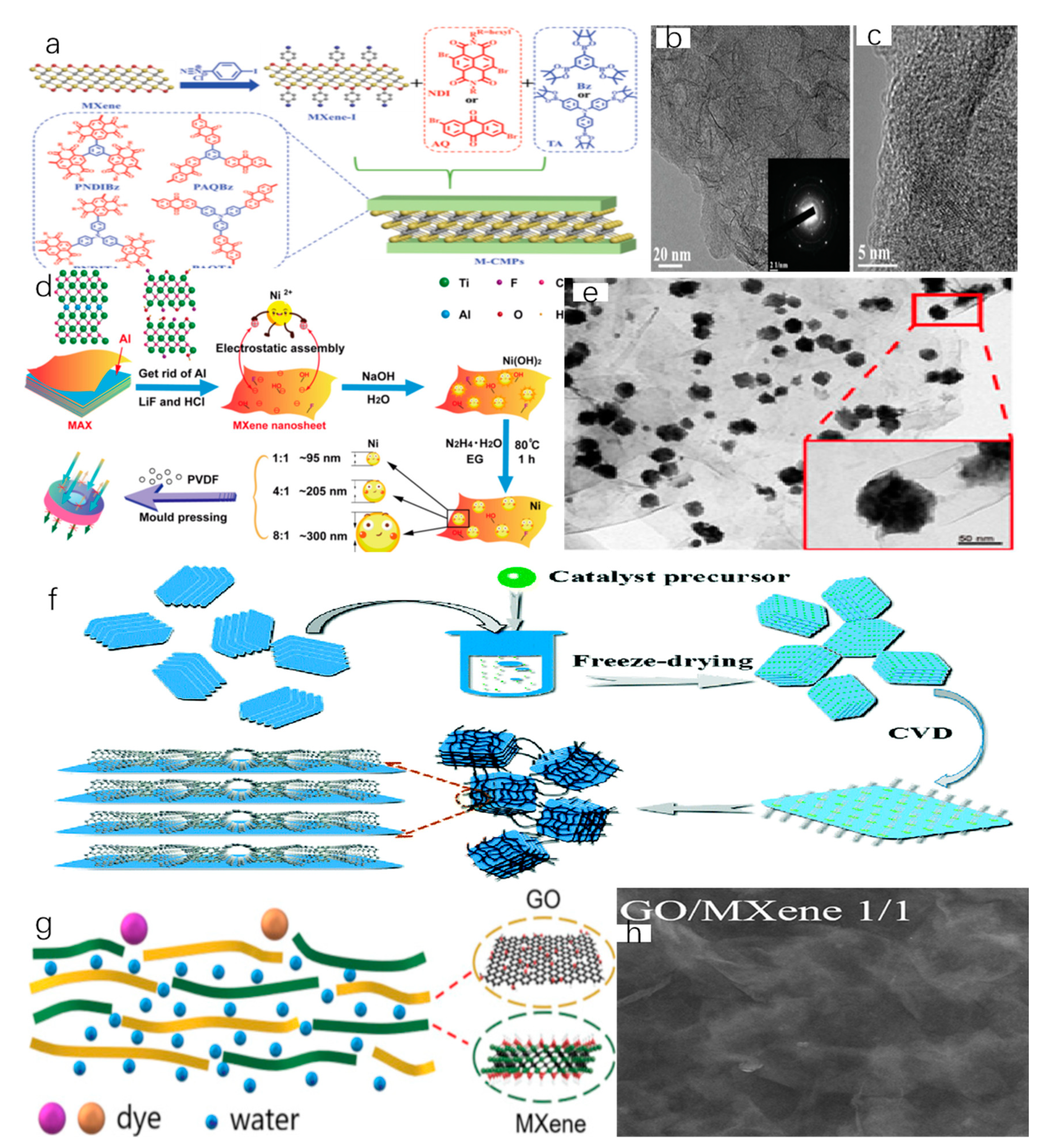


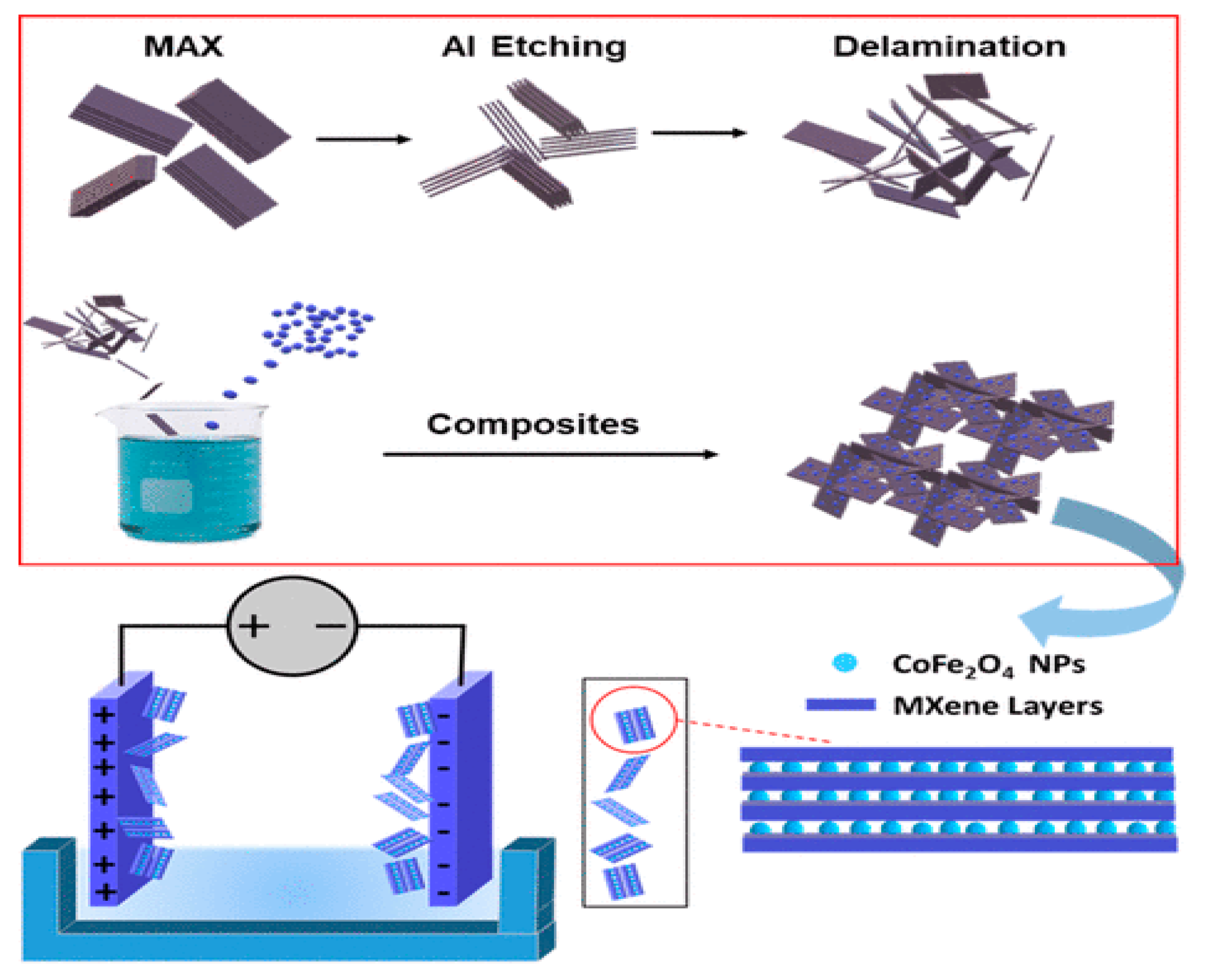
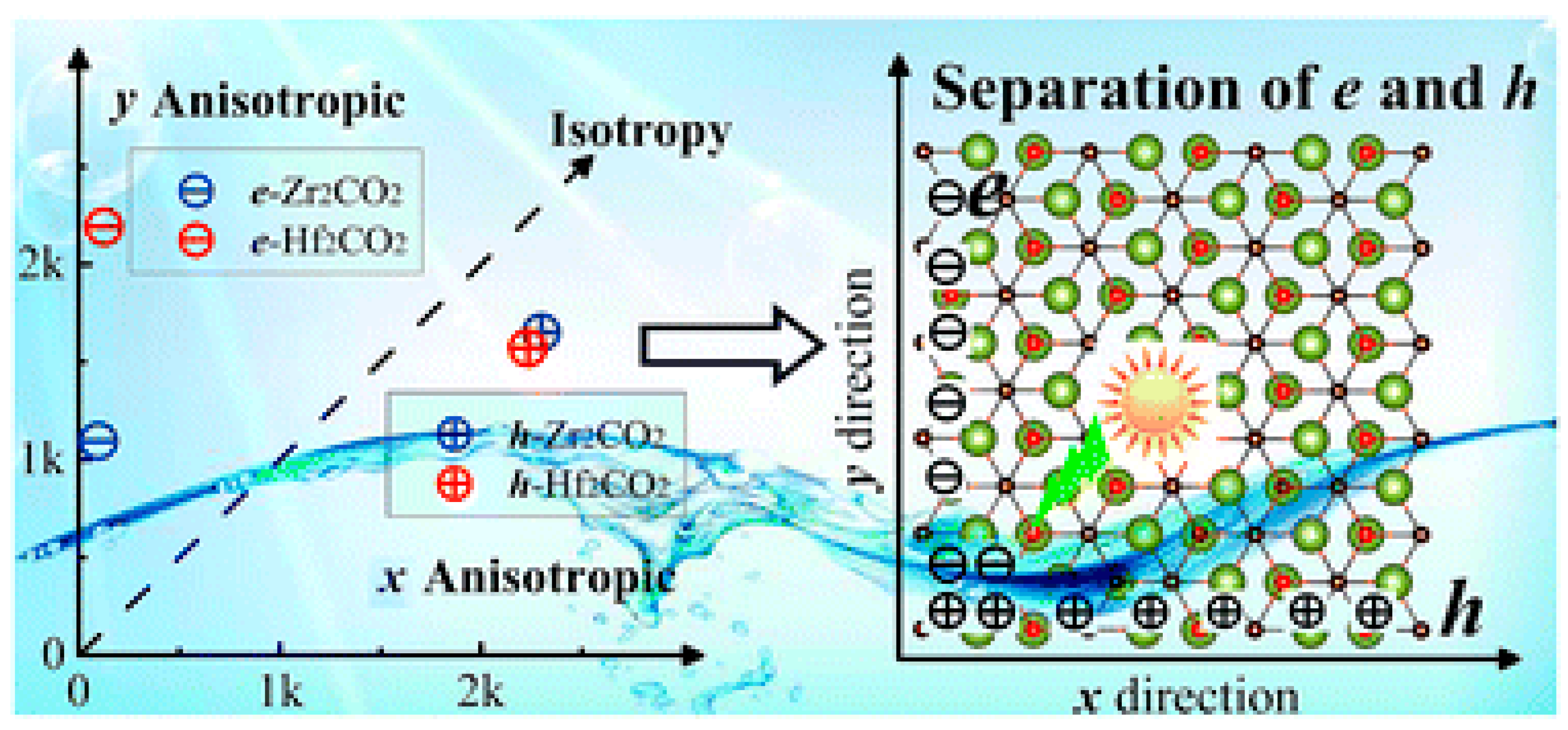

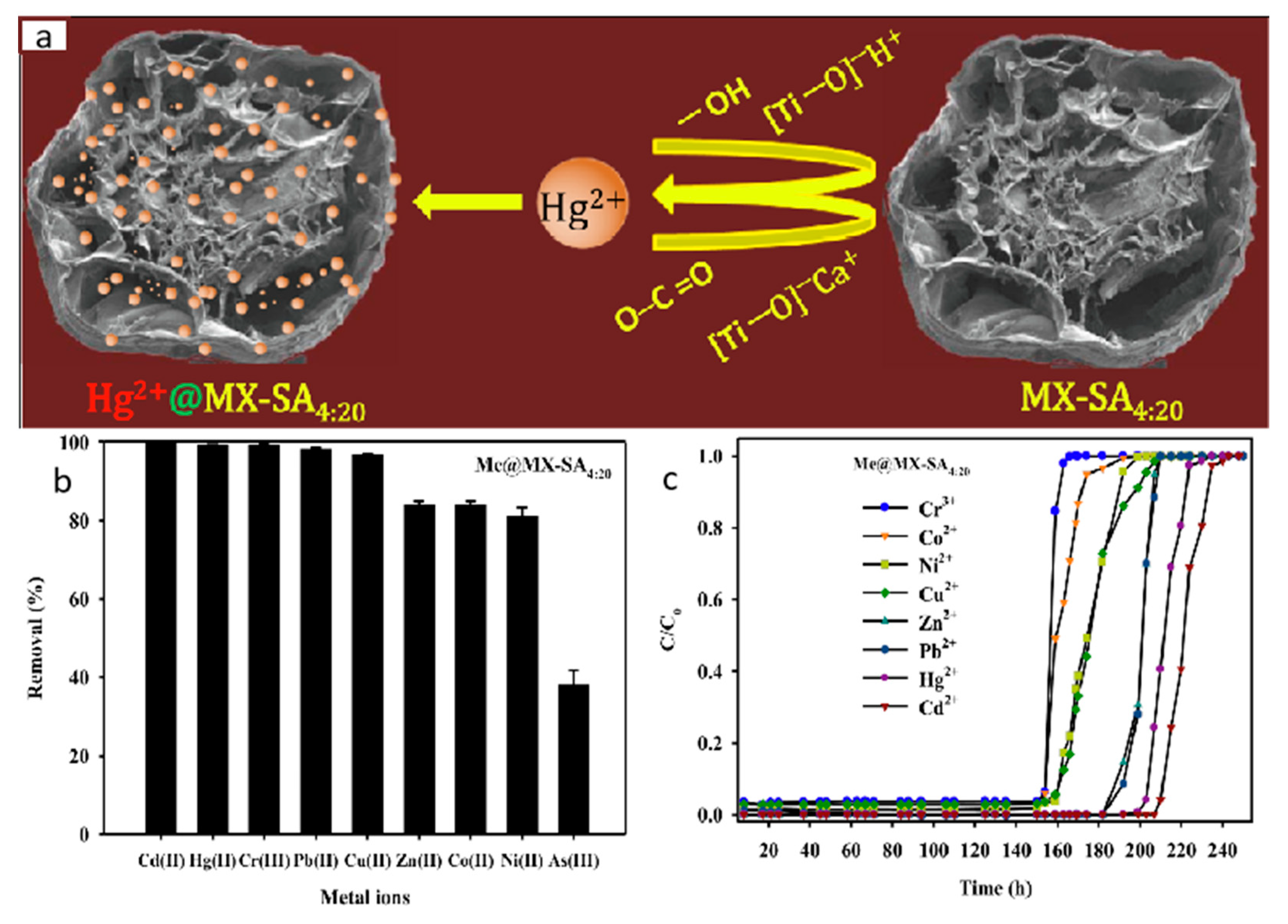
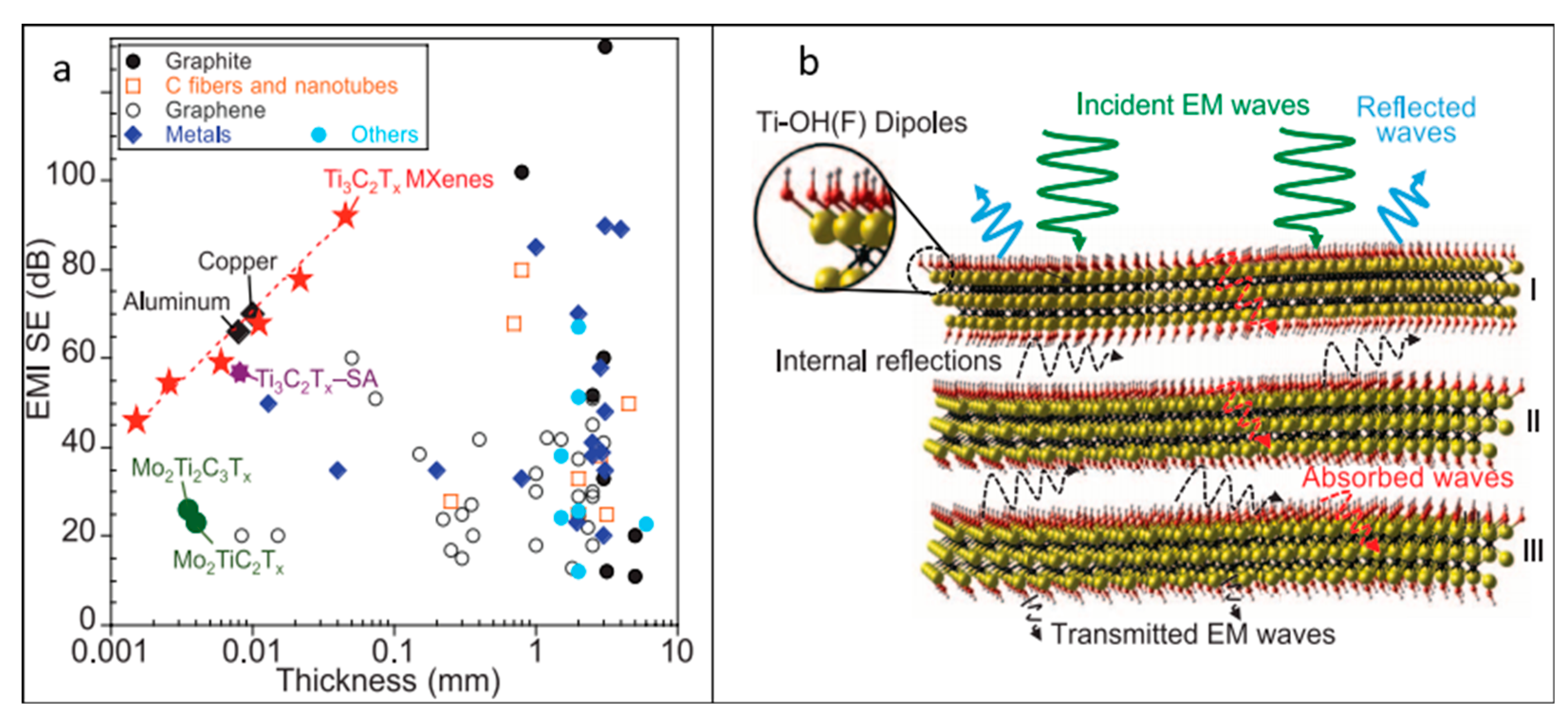
| Fabrication Methods | Advantages and Drawbacks | MC MXenes | Challenges | Ref. |
|---|---|---|---|---|
| CVD | Advantages: (1) large lateral size (2) Extremely low defect concentration Drawbacks: (1) Low efficiency (2) Complicated process | Mo2C and WC | How to change the experimental conditions, such as temperature and CVD growth time, to adjust the size and thickness of the two-dimensional α-Mo2C crystal. | [34] |
| TaC | Control CVD growth time and temperature to form a good interface between the ultra-thin TaC material and the substrate, thereby significantly improving the protective properties such as oxidation and wear. | [35] | ||
| HF etching | Advantages: (1) High selectivity (2) Acceptable yield Drawbacks: (1) Highly corrosive (2) Defects in the final product | Ti3C2 | Control the morphology, particle size, surface termination groups, defect concentration and yield of MXenes; pay attention to the MAX phase and etching conditions (HF concentration, etching time and temperature). | [42] |
| V2C | To etch V2AlC using a mixture of lithium fluoride and hydrochloric acid; to eliminate by-products to synthesize higher purity V2C. | [43] | ||
| Ti2C | To tailor the surface functional groups of the MXene 2D layer and use itself as another variable to adjust its performance such as wettability, electrical and electrochemical performance. | [38] | ||
| Molten salt method | Advantages: (1) Improve the chemical safety of the experimental process (2) Reduce the difficulty and cost of waste liquid treatment Drawbacks: (1) The formation mechanism of Cl-MXene is unclear (2) More etching time and higher reaction temperature. | Ti2C | To optimize the molar amount of molten ZnCl2 to promote the formation of Cl-MXenes, since the molar ratio of Al-MAX/ZnCl2 is a key factor in determining the final product. | [48] |
| Ti3C2 | Expand the range of MXene prepared by the Lewis acid etching route, and continue to study how to customize the surface chemistry and performance of Ti3C2 MXene material by changing the test parameters during the experiment. | [39] | ||
| Electrochemical etching | Advantages: (1) With high efficiency, and high yield (2) Safety and low cost Drawbacks: Excessive etching will destroy the MXene structure | Cr2C and V2C | How to optimize the etching voltage to use Cr2C and V2C as effective electrocatalysts for oxygen release reaction and hydrogen release reaction | [33] |
| Ti3C2 | By optimizing the electrochemical etching parameters to reduce the production of carbon derivatives, high-quality Ti3C2 can be obtained | [40] | ||
| Hydrothermal method | Advantages (1) Large interlayer distance and large specific surface area (2) Environmental- friendly Drawbacks: (1) Easy to form by-products, such as aluminum hydroxide (2) Few studies on the formation mechanism of crystal nuclei and high dependence on equipment | Ti3C2 | How to control the temperature and alkali concentration to remove aluminum compounds, promoting the entire etching process to the production of MC MXene. | [41] |
| Nb2C | Control the temperature and hydrothermal time to form a slow-release mechanism in the hydrothermal process to obtain Nb2C materials with higher c lattice parameters, greater distance between layers and greater BET specific surface area. | [54] |
| Electronic Devices | MXene-Materials | Functions | Performance | Ref. |
|---|---|---|---|---|
| SIBS | Ti3C2/NiCoP | Energy storage | Unique synergy between NiCoP nanoparticles and Ti3C2 framework, the as-prepared Ti3C2/NiCoP electrode exhibits reversible capacity, high rate performance and excellent cycle performance. | [72] |
| Supercapacitors | V2C | Energy storage | Excellent specific capacitances were achieved, specifically 487F/g in 1M H2SO4, 225F/g in 1M MgSO4, and 184F/g in 1M KOH, which are higher than previously reported values for few micrometer-thick delaminated MXene electrodes. | [74] |
| LIBs | Mo2C | Energy storage | As the anode material of rechargeable batteries, the synthesized Mo2C MXene has a capacity of 150 mAh g−1 for LIBs, showing excellent rate performance and cycle stability. | [75] |
| Battery-like SCs | CoF/MXene | Energy storage | The maximum specific capacitance of CoF NPs, MXene, and CoF/MXene composites was observed to be about 594, 1046.25, and 1268.75 Fg–1 at 1 A g–1, respectively. The calculated specific capacity of the CoF/MXene composite was about 440 Cg–1 at 1 A g–1 and proved to be an excellent hybrid electrode material by providing only 0.25 Ω charge transfer resistance. The as-synthesized material demonstrated the excellent capacitance retention, about 97%, up to 5000 cycles. | [76] |
| Spercapacitors | Ti3C2Tx-K | Energy storage | The electrode prepared from the K+ assisted self-assembly of Ti3C2Tx nanosheets (Ti3C2Tx-K) exhibits an excellent capacitance up to 1025 mF cm2 (427 Fg−1) at a scan rate of 2 mV s−1 and impressive rate capability and cycle stability. | [77] |
| Stealth devices | Ni@Ti3C2 | Electromagnetic Wave-Absorbing | Excellent impedance matching, magnetic coupling effect, conductance, magnetic lose and multiple scattering contribute to the excellent electromagnetic wave absorption performance of the Ni@MXene hybrid. By combining the excellent dielectric properties of (Polyvinylidene Fluoride) PVDF, the EM wave-absorbing performance of the Ni@MXene hybrid is developed to a great extent. The PVDF composite with 10 wt% Ni@MXene 8:1 hybrid shows relatively hunk absorbing properties with an RLmin of −52.6 dB at 3 mm and optimal EAB of 6.1 GHz. By adjusting the sample thickness, the EAB of all of the hybrid composites can cover completely the whole X-band. | [58] |
| Wearable radio-frequency wireless communicators | Ti3C2Tx-SWNT | Electromagnetic interference shielding | The resulting MXene-single-walled carbon nanotubes (S-MXene)/latex device was able to sustain up to 800% areal strain and demonstrated strain-insensitive resistance profiles for 500 stretching/relaxation cycles, which encouraged its applications in stretchable EMI shielding and wireless communicators. A layer of stretchable S-MXene conductor demonstrated strain-invariant EMI shielding performance ≈30 dB under wide ranges of areal strains, and the shielding performance was improved to 47 and 52 dB by stacking 5 and 10 layers of S-MXene conductors, respectively. | [100] |
| Next-generation smart devices | Ti3C2/Graphene | Electromagnetic interference shielding | The EMI SE of Mxene can reach 50.7 dB, which is higher than the EMI SE of reduced GO foam. Mxene’s high conductivity and lightweight characteristics make it have excellent specific shielding effectiveness (6217 cm3 g−1) | [102] |
| Ultra-thin electromagnetic shielding coating | TiC2Tx/PEDOT:PSS | Electromagnetic interference shielding | The thickness of TiC2Tx/PEDOT:PSS is only 11.1 μm, but it shows a high EMI SE value of 42.10 dB. Compared with pure Ti3C2Tx MXene film, the tensile strength increased from 5.62 MPa to 13.71 MPa, and the fracture strain increased from 0.18% to 0.29%. | [104] |
Publisher’s Note: MDPI stays neutral with regard to jurisdictional claims in published maps and institutional affiliations. |
© 2021 by the authors. Licensee MDPI, Basel, Switzerland. This article is an open access article distributed under the terms and conditions of the Creative Commons Attribution (CC BY) license (http://creativecommons.org/licenses/by/4.0/).
Share and Cite
Wan, K.; Li, Y.; Wang, Y.; Wei, G. Recent Advance in the Fabrication of 2D and 3D Metal Carbides-Based Nanomaterials for Energy and Environmental Applications. Nanomaterials 2021, 11, 246. https://doi.org/10.3390/nano11010246
Wan K, Li Y, Wang Y, Wei G. Recent Advance in the Fabrication of 2D and 3D Metal Carbides-Based Nanomaterials for Energy and Environmental Applications. Nanomaterials. 2021; 11(1):246. https://doi.org/10.3390/nano11010246
Chicago/Turabian StyleWan, Keming, Yalin Li, Yan Wang, and Gang Wei. 2021. "Recent Advance in the Fabrication of 2D and 3D Metal Carbides-Based Nanomaterials for Energy and Environmental Applications" Nanomaterials 11, no. 1: 246. https://doi.org/10.3390/nano11010246





